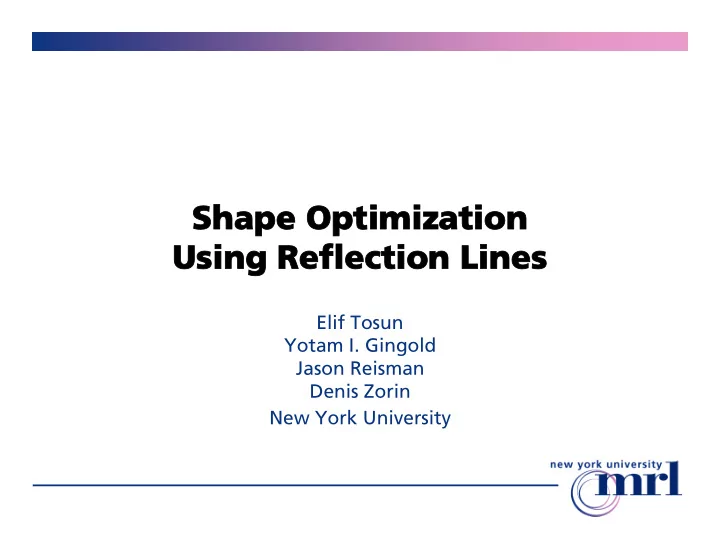

Shape Optimization Shape Optimization Using Reflection Lines Using Reflection Lines Elif Tosun Yotam I. Gingold Jason Reisman Denis Zorin New York University
Reflections are sensitive to surface shape depend on local quantities depend on viewer location “Cloud Gate” Anish Kapoor
Reflection Lines Capture aspects of general reflections Show surface imperfections better than lighting only Tool for surface quality assessment Interactive rendering, easy to implement
Problem Surface quality and shape design complimentary Control of shape has indirect effect on quality surface surface control interrogation Formulate surface editing as an optimization problem
Problem Surface Interrogation Surface f Reflection Function θ (f) Reflection Lines
Problem Surface Interrogation Surface f Reflection Function θ (f) Reflection Lines User defined Reflection Function θ *
Problem Surface Interrogation Surface f Reflection Function θ (f) Reflection Lines User-defined Reflection Function θ *
Our Solution Interactive surface modeling tool based on reflection line optimization Mesh based - discretization of reflection lines Smoothing, warping, changing line density and direction, image based reflection Approach before after Local parameterization over image plane Triangle-based discretization of derivatives
Related Work Klass 1980 differential-geometric description Horn 1986 shape from shading Loos, Greiner and Seidel 1999 reflection lines on NURBS Hildebrandt, Polthier and Wardetzky 2005 Grinspun, Gingold, Reisman and Zorin 2006 discrete shape operators
Reflection Line Function
Reflection Line Function
Reflection Line Function
Reflection Line Function
Reflection Line Function
Reflection Line Function
Reflection Line Function
Image-Plane Parameterization silhouette pt reflection line dir. Image viewing plane direction surface as height field
Reflection Functionals Function-based User defined reflection func. Gradient-based
Reflection Functionals Function-based Gradient-based Euler-Lagrange 2nd order Euler-Lagrange 4th order Can prescribe only function Can prescribe function and values on boundary derivative values on boundary No blending with rest of Smooth blending at selection surface boundaries selected area with prescribed high density fixed vertices
Gradient Discretization , , Triangle-centered Piecewise linear finite elements
Hessian Discretization At least 6 DOF per stencil needed -- triangle with flaps Triangle-averaged Averaging shape operators over triangle edges [Hildebrandt et al. 2005], [Grinspun et al. 2006]
Hessian Discretization At least 6 DOF per stencil needed -- triangle with flaps Triangle-averaged Averaging shape operators over triangle edges [Hildebrandt et al. 2005], [Grinspun et al. 2006] A, A i : area factors H(f) =
Hessian Discretization Triangle-averaged Pros robust simple consistent for special meshes. Cons for general meshes, mesh-dependent error
Hessian Discretization Quadratic interpolation Unique quadratic function to interpolate vertices of stencil Use quadratic term coefficients Pros Consistent Less dependent on mesh connectivity Cons Less robust - if vertices on or close to a conic no solution or large coefficients
Hessian Discretization Hybrid discretization Use triangle-averaged scheme when quadratic interpolation unstable Evaluate stability by comparing coeffs to Pros: More robust More accurate Cons: Large errors for some meshes
Hessian Discretization Quad fit Initial Tri-avg Hybrid
Hessian Discretization
Hessian Discretization
Hessian Discretization
Hessian Discretization
Normal Es Estimation Local quadratic fit (O(h 2 )) 1. Project to plane perpendicular to initial normal
Normal Es Estimation Local quadratic fit (O(h 2 )) 1. Project to plane perpendicular to initial normal 2. Fit a quadratic in the new coord system 3. Use the normal as vertex normal
Normal Estimation analytic normals mesh averaged quadratic fit face normals normals
Interactive Speeds Linearizing the energy does not work Full non-linear Newton or gradient-only methods too expensive Solution: Inexact Newton method with line search Compute and factor Hessian once and reuse Compute Hessian for the linearized problem
Interactive Speeds backward forward 5x Gain 10x Gain
Reflection Line Manipulation Changing density init low density Line density Movie - WMV Line density Movie – MP4 high density
Reflection Line Manipulation Changing density low high density density
Reflection Line Manipulation Changing direction Rotation Movie - WMV Rotation Movie – MP4
Reflection Line Manipulation Changing direction Car example movie - WMV Car example movie - MP4
Reflection Line Manipulation Smoothing reflection lines Target values through smoothing
Reflection Line Manipulation Smoothing reflection lines Target values through smoothing
Reflection Line Manipulation Smoothing reflection lines Target values through smoothing Directional smoothing
Reflection Line Manipulation Smoothing reflection lines Target values through smoothing Directional smoothing
Reflection Line Manipulation Warping
Reflection Line Manipulation Warping Warping on car movie - WMV Warping on car movie – MP4
Reflection Line Manipulation Warping
Reflection Line Manipulation Image based reflection pattern
Conclusions/Future Work Interactive system to optimize shapes of surfaces based on reflection lines Image-plane parameterization Simple triangle-based Hessian discretization Future Work Integration with silhouette editing of [Nealen, Sorkine, Alexa and Cohen-Or 2005]
Acknowledgements Robb Bifano Eitan Grinspun Jeff Han Harper Langston Ilya Rosenberg SGP Reviewers This work is partially supported by award NSF CCR-0093390, IBM Faculty Partnership Award and a Rudin Foundation Fellowship
Recommend
More recommend